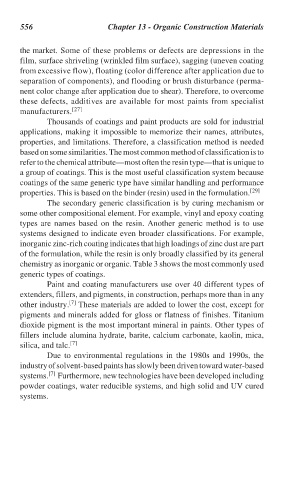Page 586 - Handbook of Thermal Analysis of Construction Materials
P. 586
556 Chapter 13 - Organic Construction Materials
the market. Some of these problems or defects are depressions in the
film, surface shriveling (wrinkled film surface), sagging (uneven coating
from excessive flow), floating (color difference after application due to
separation of components), and flooding or brush disturbance (perma-
nent color change after application due to shear). Therefore, to overcome
these defects, additives are available for most paints from specialist
manufacturers. [27]
Thousands of coatings and paint products are sold for industrial
applications, making it impossible to memorize their names, attributes,
properties, and limitations. Therefore, a classification method is needed
based on some similarities. The most common method of classification is to
refer to the chemical attribute—most often the resin type—that is unique to
a group of coatings. This is the most useful classification system because
coatings of the same generic type have similar handling and performance
properties. This is based on the binder (resin) used in the formulation. [29]
The secondary generic classification is by curing mechanism or
some other compositional element. For example, vinyl and epoxy coating
types are names based on the resin. Another generic method is to use
systems designed to indicate even broader classifications. For example,
inorganic zinc-rich coating indicates that high loadings of zinc dust are part
of the formulation, while the resin is only broadly classified by its general
chemistry as inorganic or organic. Table 3 shows the most commonly used
generic types of coatings.
Paint and coating manufacturers use over 40 different types of
extenders, fillers, and pigments, in construction, perhaps more than in any
[7]
other industry. These materials are added to lower the cost, except for
pigments and minerals added for gloss or flatness of finishes. Titanium
dioxide pigment is the most important mineral in paints. Other types of
fillers include alumina hydrate, barite, calcium carbonate, kaolin, mica,
silica, and talc. [7]
Due to environmental regulations in the 1980s and 1990s, the
industry of solvent-based paints has slowly been driven toward water-based
[7]
systems. Furthermore, new technologies have been developed including
powder coatings, water reducible systems, and high solid and UV cured
systems.

